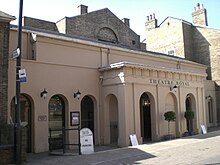Theatre Royal, Bury St. Edmunds

Theatre Royal, Bury St Edmunds exterior
|
|
| Address | Westgate Street Bury St Edmunds England |
|---|---|
| Coordinates | 52°14′26″N 0°43′02″E / 52.2406°N 0.7172°E |
| Owner | Greene King Brewery |
| Designation | Listed Building Grade I |
| Capacity | 360 |
| Current use | Theatre |
| Construction | |
| Opened | 1819 |
| Renovated | 2005 -2007 |
| Architect | William Wilkins |
| Website | |
| http://www.theatreroyal.org/ | |
The Theatre Royal is a restored Regency theatre in Bury St. Edmunds, Suffolk, England. The building is one of eight Grade I listed theatres in the United Kingdom, and is the only working theatre operated under the auspices of the National Trust.
The theatre presents a diverse programme of drama, music and stand up. It regularly produces its own work which tours nationally, most recently Torben Bett's Invincible in the summer of 2016. In early 2017 the Theatre Royal will produce an adaptation of Jane Austen's Northanger Abbey, which will tour nationally.
The Theatre Royal is currently a member of the pioneering Black Theatre Live partnership, a consortium of eight UK theatres committed to effecting change nationally for touring through a sustainable 3-year programme of national touring, structural support and audience development.
The Theatre Royal was opened by its proprietor and architect William Wilkins on 11 October 1819, and was one of the most elegant, sophisticated and up-to-date playhouses of its age. The fact that it has survived, without significant alteration, into our time is a miracle and it is now one of only three buildings to give the experience of theatre-going in pre-Victorian Britain.
Wilkins was an architect of national repute, responsible for, amongst other buildings, the National Gallery in London and Downing College, Cambridge. As the proprietor of the Norwich circuit, he employed a small company of players to undertake an annual tour of six theatres, Yarmouth, Ipswich, Cambridge, Bury St Edmunds, Colchester and King's Lynn. Each was open for just one or two short seasons during the year. The Bury theatre opened for the Great Fair in early October to mid-November and was only available for special events at other times of the year. At that time, it would certainly have enjoyed large audiences particularly as the local community would not have been able to travel far for entertainment, until the arrival of the railway in the 1840s.
...
Wikipedia
